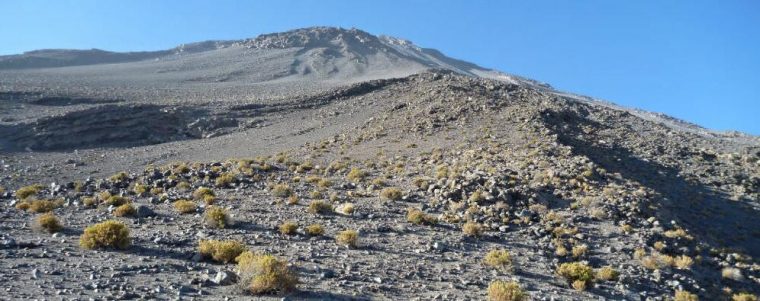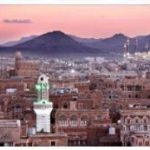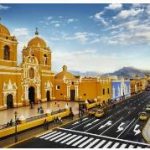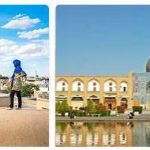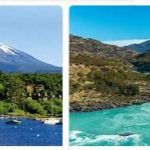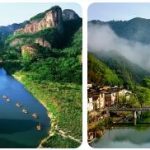Arequipa is Peru’s second largest city, despite the fact that the capital Lima is ten times as large. The city was built as a Spanish colonial seat, founded by the Spaniards on August 15, 1540. To this day, the city’s origins are celebrated with a week-long festival.
For the Peruvians, the city has a very special architectural significance. In the year 1868, the city was destroyed during a violent earthquake, and the locals therefore spent a number of years rebuilding the city. This time the construction took place with the unique volcanic rock type sillar , which has a recognizable white / pink color.
Arequipa’s location
The city of Arequipa unfolds in the south of beautiful Peru. Here the city guards 2,300 meters above sea level. Yet the enchanting river with the whimsical name Chili runs . If you take seven kilometers from the city limits, it will be possible to get one on the experience, and river rafting down the rushing river.
Arequipa has it like the plum in an egg, densely surrounded by huge volcanoes. These surroundings affect the climate of the city in the strangest way. The temperature here is never above 25 degrees, but also never below 10 degrees. The period December to March is called the wet months and the rain falls heavily in these months.
Experiences in Arequipa
The old part of town
During the colonial era in Peru in the 19th century, the old town of Arequipa was built. It was especially this part of the city that suffered major damage during the Peruvian earthquake in the year 1868. The old town is an attractive sight among many tourists.
After the earthquake, the locals rebuilt the city. This time, each a small house was built alike and in the stone type sillar . This gives the district a very special radiance, as it stands and shines in white and pink colors. The city consists of a total of 5,817 properties, of which the 500 buildings are listed.
Mountain climbing at El Misti
Peru is a very mountainous country where the heights vary widely. Arequipa is no exception. Among the hilly terrain, the volcanic mountain “El Misti” reigns. The mountain has a height of 5,822 meters, but that has not stopped many tourists from going out on mountain hiking here.
On the hiking route, the ascent is not really that bad. Nor is the mountain technically difficult to climb, although it does require a good physique to reach the top. There is quite a long way to the top, and the trip therefore takes two days. Already on the first day we reach an altitude of 4,500 meters, where we spend the night in a base camp.
In addition to being a physically hard ride, it is also extremely cold to climb El Misti. Once the sun goes down and we have reached a certain height, the temperature will drop all the way down to -29 degrees. Very warm clothes are therefore a must.
The best months to climb this amazing volcanic mountain are in the period between April and December, and especially in the high season from July to November. This is because during these months there is hardly as much rain as in the remaining “wet months”.
The Cathedral
Arequipa’s beautiful cathedral was originally built in the 17th century, but has since been rebuilt inseparably. Therefore, the huge building remains majestic in the city. The cathedral is just as beautiful inside behind the walls as it is outside. Here is both beautiful and bright.
Inside, the building is adorned with twelve pillars, each symbolizing one of the twelve apostles. The southern European footprints, which over time have been deposited in Arequipa, have also left their mark on the cathedral. The columns are made of Italian marble, for example, and a large magnificent brass lamp in Byzantine style has been shipped to the cathedral all the way from Spain.
In the year 1870, the cathedral also received a gift from Belgium, in the form of an organ which is said to be the largest in South America. However, the beautiful organ suffered damage during cargo, which is why the devout followers of the cathedral had to listen to distorted tones for over a hundred years.
Museo Santuarios Andinos
This is actually a small modest museum, which has nevertheless won the hearts of tourists as well as Peruvians. The stay at the museum takes place with an enthusiastic and knowledgeable guide by your side. The tour kicks off with a twenty-minute long film. This video clip is so beautifully filmed, and deals with the entire museum’s top attraction – the Ice Princess Juanita.
Juanita was a 12-year-old Inca girl who was sacrificed on top of the volcano Mount Nevado Ampato several hundred years ago. Today, Juanita is put on display at Santuarios Andinos, frozen in a glass freezer.
The exhibition may seem a bit macabre to some, although the story of the ice princess Juanita is admirable and descriptive of reality. The remaining parts of the museum are adorned with objects and finds from all over the world, which relate to the little girl’s funeral.
Casa Ricketts
Casa Ricketts was built in the year 1738. The building has since had several different functions. Among other things, Casa Ricketts has been used as a parsonage, mansion for the archbishop and most recently school and home for the wealthy families in the city.
Today, Arequipa’s most well-functioning bank is behind the huge walls. Some would even argue that there is no more successful bank in all of Peru. Despite the fact that you do not have money matters to take care of, the outer area around Casa Ricketts is something so admirable.
If you go up in architecture and beautiful details, then take a step closer to Casa Ricketts. Every detail on the walls of the building is done with care. The beautiful courtyards that surround Casa Ricketts are worth a walk in. These are adorned with beautiful fountains, shaped like guarding puma heads.
Arequipas history
“Dear child has many names”, and this also applies to cities. There is no doubt that Arequipa is close to the heart of the Peruvians, which is why the city also collects many myths and stories. Especially the locals, whose ancestors built the city from scratch after the earthquake in 1868, carry a very special love for the city.
Two stories in particular about the city’s name recur. First of all, “Ari” means top , and “quipa” means behind . Since El Misti sits high in front of the city, it is said that the name Arequipa roughly translated means “The place behind the top”.
Even a Inca king worthy
Rumor has it that it is the fourth Inca king Mayta Cápac who is the reason for Arequipa’s name. The story goes that when the fourth Inca king traveled through the valley, he was enchanted by the beautiful area. Therefore, he shouted to his followers “Are quipay!”, Which means “Yes, stop!”.

